Home-made stock is an important success factor to many dishes and sauces. It is vastly superior to bouillon cubes and in most cases also better than anything else you can buy in a store. It’s not hard to make — it just takes a bit of time. After the success of pressure-cooked chicken stock I am a strong supporter of using a pressure cooker to make stock (with the most important reason more flavor, not the shorter cooking time), and so I also prepared this beef stock in my pressure cooker. You could however also prepare it in an ordinary pot and it will still turn out great.

‘Brown’ stock means that the bones and vegetables used for the stock have been browned in the oven before they were used to make the stock, which gives the stock a deeper flavor. I used oxtail for the meat and bones since I had some oxtail in my freezer that I wanted to use up, but you could also use other beef bones and meat to make beef stock. The amounts in this recipe are based upon Modernist Cuisine, but I omit the garlic and use oxtail instead of ground beef and a calf’s foot.
Ingredients
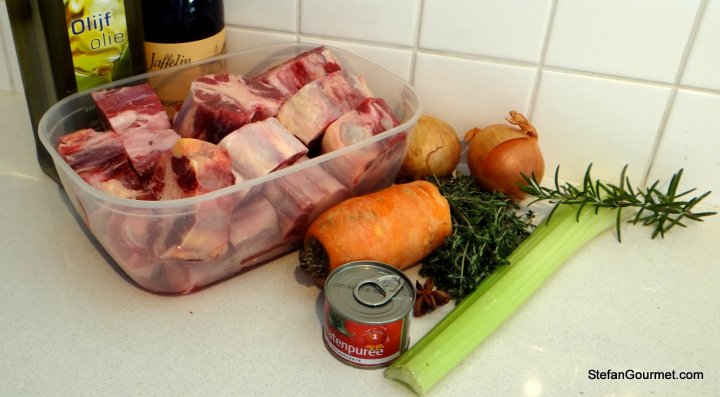
For about 2 litres (2.2 quarts) of stock
2 kilograms (4.4 lbs) oxail or other combination of beef meat and bones
250 ml (1 cup) red wine
200 grams (.44 lbs) onions
200 grams (.44 lbs) carrots
1 stick celery
50 grams (2 oz) double-concentrated tomato paste (or double that amount single-concentrated)
16 grams (.5 oz) fresh thyme
3 grams (1 sprig) rosemary
1 star anise
80 ml (1/3 cup) olive oil (or beef suet)
Preparation
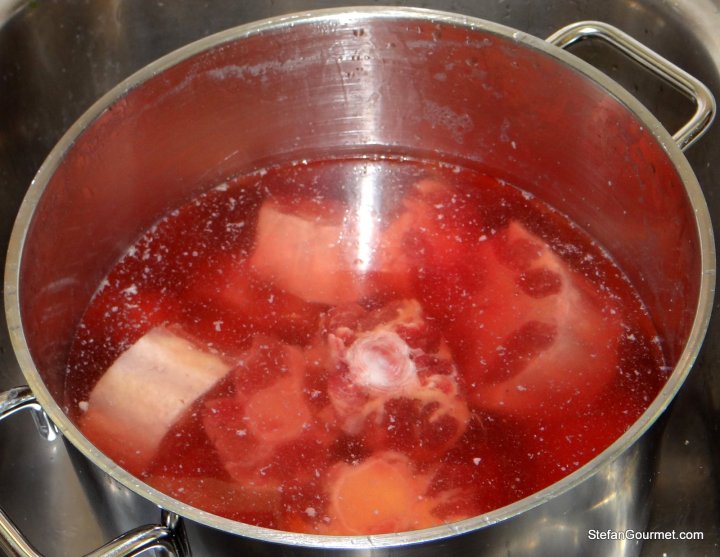
Preheat the oven at 190C/375F. Soak the meat and bones in cold water for 10 minutes.

Drain and pat dry with paper towels.
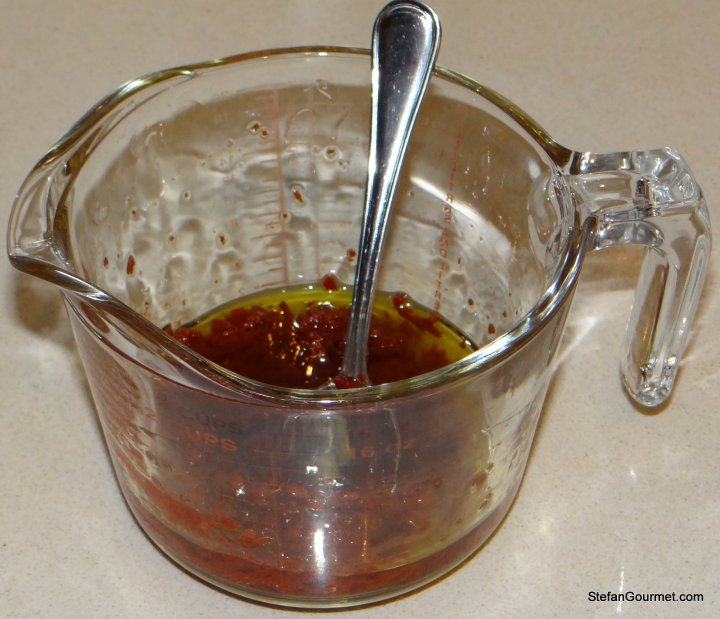
Mix the oil and the tomato puree in a small bowl.
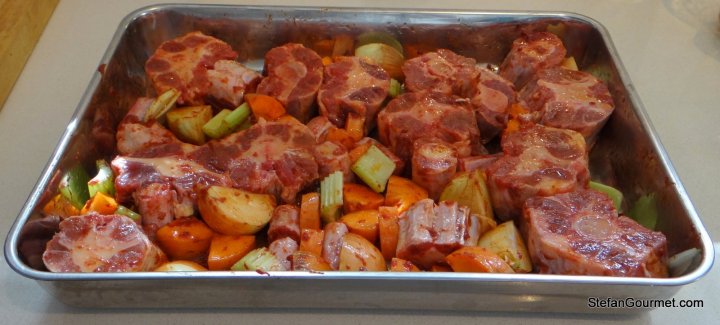
Roughly chop the vegetables. Put the vegetables and the meat in a roasting tray. Add the tomato mixture and toss to coat on all sides. The mixture of tomato and oil will help the browning process and will deepen the flavor.

Roast for 1 hour at 190C/375F.

Add the contents of the roasting tray, including the liquid, to the pressure cooker (or stock pot).
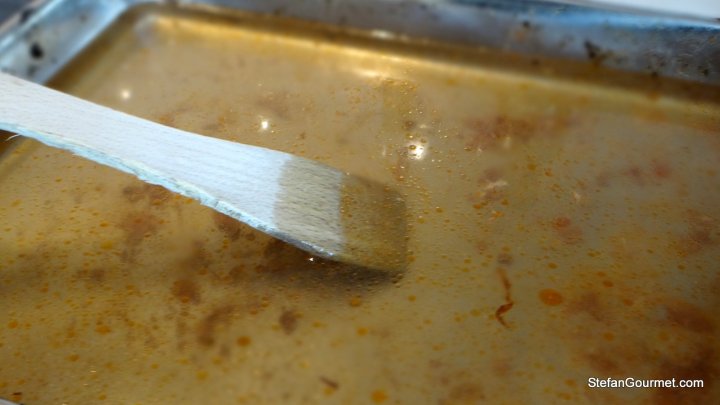
Put about 2 litres of water in the roasting tray and scrape the browned bits off the bottom with a wooden spatula. Add this water to the pressure cooker (or stock pot). This is to get all of the flavor in the stock.
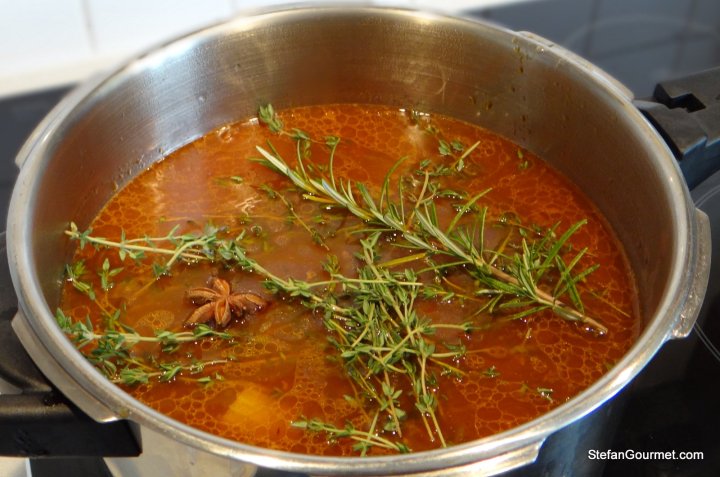
Finally, add the thyme, rosemary, and star anise.
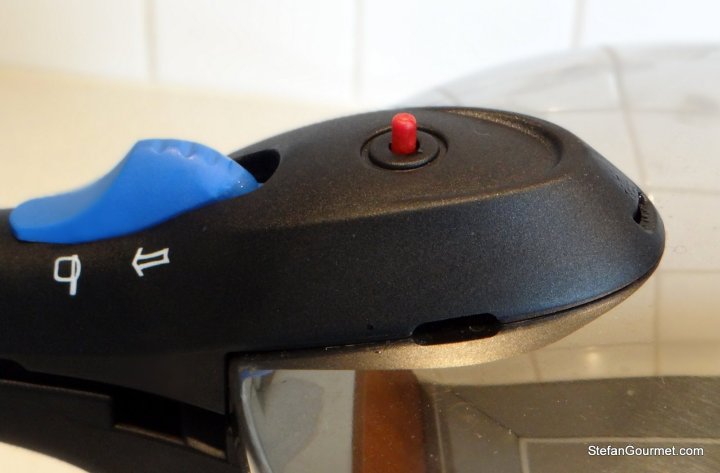
Close the pressure cooker and heat over high heat until the pressure indicator pops out. Lower the heat and cook for 2.5 hours.
If using a stock pot, bring to a boil and then simmer, covered, for 5 hours.
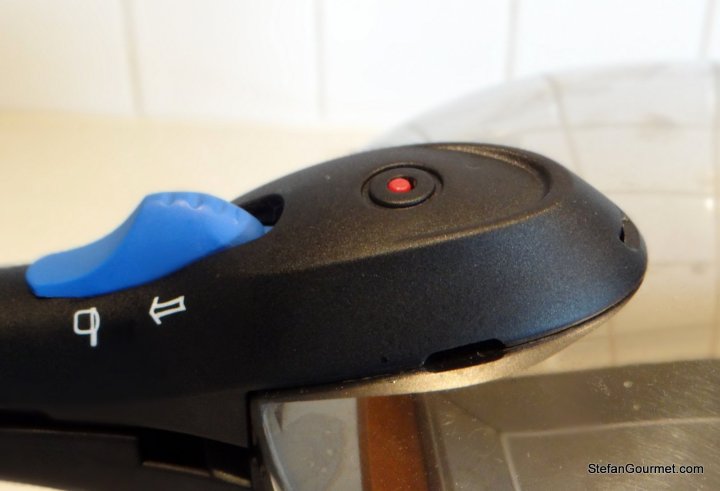
At the end of the cooking time, turn off the heat and wait until the pressure indicator is back in its original position.
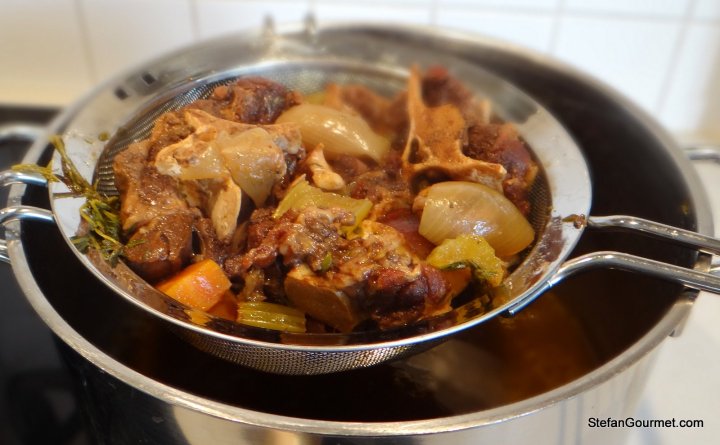
Filter out the solids with a fine sieve.
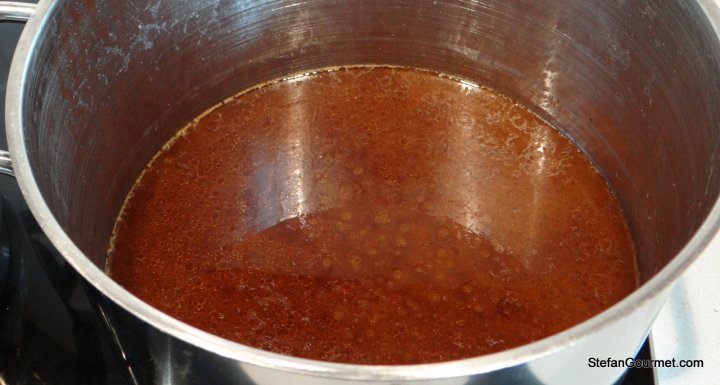
Allow the stock to cool. It is best to do this quickly with an ice bath. When the stock is cool, the fat will be a solid layer that floats on top that can easily be removed and used to make a wonderful pasta dish with cauliflower.
The stock can be used straight away, or frozen. To make beef demi-glace, simmer the beef stock until reduced to only about 1/5 of the original amount. Never add salt to stock before it has reached the desired concentration, otherwise your preparation may be ruined by being too salty.
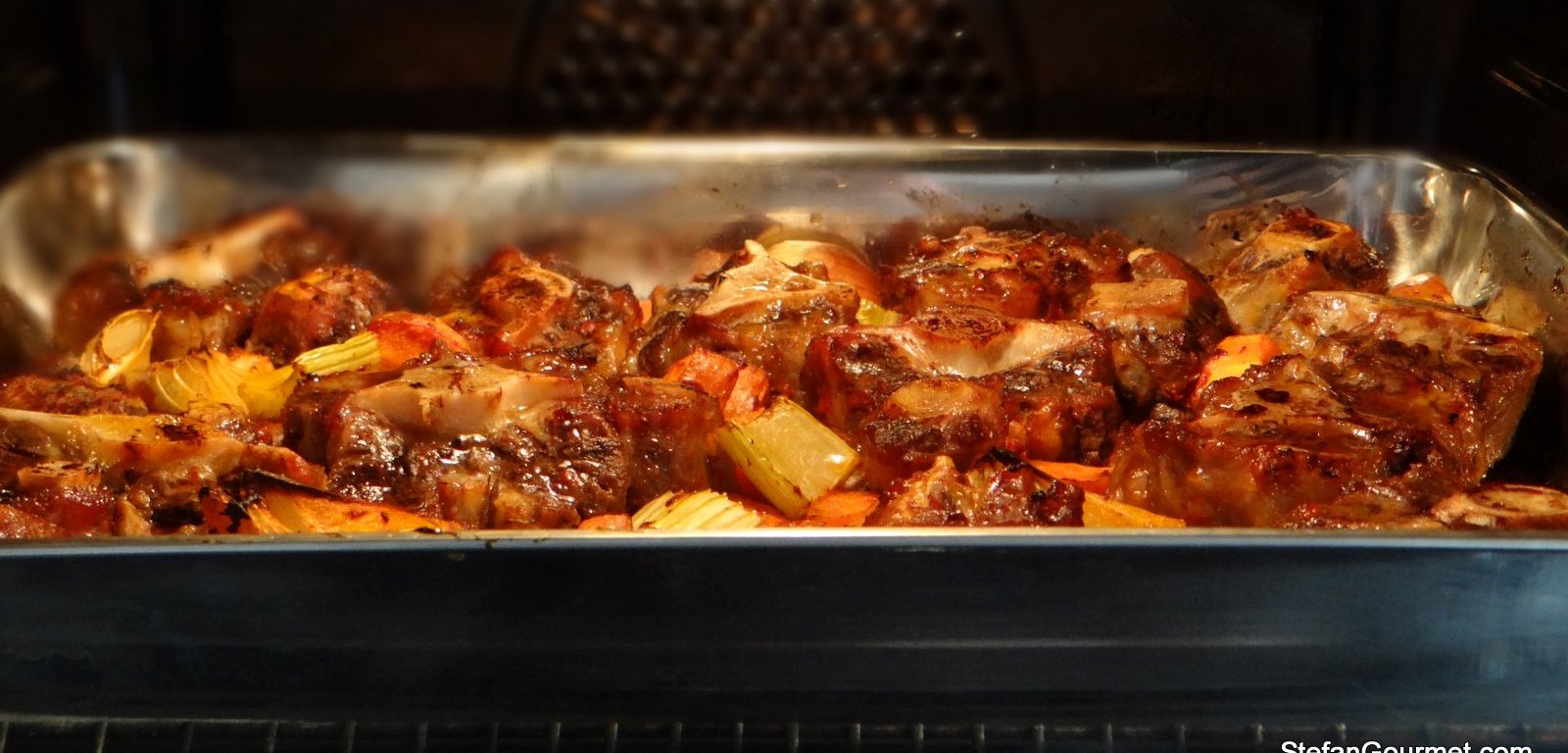



I’ve been wanting to learn more on how to make a good brown beef stock. Great step by step instructions. Thank you so much.
LikeLike
You’re welcome, glad you like it and looking forward to seeing you around here more often!
LikeLike
Oxtails make the best ever beef stock! I’ve heard about oven roasting the bones first, but haven’t tried it. I didn’t think the flavor could get any better… but if you say so, I’ll give it a shot. I did a post today on the health benefits of homemade soup stock, plus a soup recipe from my mom that is just great. It might even be gourmet enough to appeal to you (wink). I used left-over oxtail beef stock – imagine that 🙂
LikeLike
OK, Stefan, you don’t have a spice mill because you need a larger house but you have a pressure cooker??????? When you come to see us I hope you have an explanation. 🙂 Seriously, a spice mill takes up little to no space. A pressure cooker, well we won’t go there…;) I have made stock in large “stock pots,” you know those vessels specifically made large enough to make commercial batches of stock. I’ve made stock in household dutch ovens. I’ve made stock in commercial steam kettles that hold 20 gallons of “stuff.” I just can’t bring myself to buy a pressure cooker for making stock. I just can’t. 😦 Now, a more important question is why you soak the bones before roasting. The color of your stock is beautiful and your technique is spot on but why soak the bones and lose the flavor? I am always willing to learn unless I have to buy a pressure cooker. 😉
LikeLike
It’s not the space of the spice grinder, but the combined space needed for all kinds of tools that I would only use once in a while. Until recently I cooked almost only Italian food and this is still a large proportion. Lots of Italian recipes require one to make stock from scratch, whereas I do not know any (yet) that require a spice grinder. I regret not buying a stand mixer sooner than I did, so perhaps I should get a spice grinder too. I can already hear Kees bugging me about owning yet another kitchen tool “with a plug” 😉
As for your more important question, I am following Harold McGee’s advice. He says bones should be soaked in water before making stock to remove blood and remove “surface off flavors”. It has worked wonders for my fish stocks, where the difference is clear even without a side-by-side. Since it is soaked in cold water, I do not think a lot of flavor is lost. According to Modernist Cuisine, the flavor of white chicken stock even improves from blanching the bones. This seems counter-intuitive because then definitely some flavor is extracted into the blanching water, but they have done a blind side-by-side taste test to confirm it.
I could probably have used one of your commercial kettles right about now, because I’m making brown chicken stock out of 8 chickens for the two Burgundian evenings I’m organising — making Coq au Vin for 32. I had to do this in three batches. I’m really reaching the limits of what I can do in my home kitchen…
LikeLike
Coq au vin for 32. 😮 That’s way out of my league and I have a very large kitchen. Baby Lady & I find the perfect number of guests for a dinner party is 6. First, that is what comfortably fits around our dining room table. We can get 8 but there is too much food on the table. Second, it’s the perfect size for everyone to enjoy each other’s company and not be so loud you can’t hear the conversation. Last, prep and cleanup is manageable.
The last party we did for 30+ guests was a blast but it took me 4 days of prep and I spent the entire evening worrying about everything and ensuring the guests had a good time. I never had time to sit down or have a conversation. I was exhausted at the end of the evening. We went through 6 assorted canapés, 5 lb. roasted New Your sirloin, 5 lb. roasted pork loin, 1 lb. Serrano jamon, 6 lb. ancho crusted, seared tuna with fig-lime glaze, 7 lb. assorted cheeses, I don’t recall how much bread and other accompaniments, and 34 bottles of wine. That was 4 years ago and I haven’t had the urge to entertain that many people again. Whew! It reminded e of why I got out of the restaurant business in the first place. 😉
Good luck with your party and I hope everything comes off without a hitch.
LikeLike
Everything went fine 🙂 It was not 32 at once but 16 on two consecutive evenings. This is what fits around our extended dinner table and it was perhaps a bit loud. I also have enough plates, glasses, and flatware for 16.
I agree that 4-6 is the perfect number because then I can go all out and it is very manageable.
The nice thing about being with 16 is that we can all sample 16 different bottles of wine 🙂 For instance, we tried three different crus from the same producer, same vintage, all chardonnay, with the vineyards less than a mile apart from each other. Amazing difference. With 16 it’s easy to finish those 3 bottles with one course of the menu and then open up some more for the next course 🙂
Prep and cleanup is manageable because everyone helps out. Some people are better at cleanup, other better at prep or plating. Works out great!
I like this as a change to the normal dinners for 4-6 and do it twice each year. It started out as a single evening, but now I’m doing double evenings (so 4 evenings per year total) as to not have to disappoint too many friends.
LikeLike
Another fine instructional post, Stefan. You really have a knack for such things. As I’ve mentioned, I’ve got a beef stock post coming up but it won’t be for a while and there’s no pressure cooker and I just don’t see myself purchasing one in the near future. Nevertheless, this was a great post and one I’m sure many will reference.
LikeLike
Thanks John, looking forward to see how you make it.
LikeLike
There are quite a few very decent chicken stocks available in cans or cartons but I have *never* found a store-bought beef stock that was anything but awful!
Interesting about the pressure cooker… the only thing about a good old-fashioned stockpot is that it fills your house with lovely aromas as it simmers for hours 🙂
LikeLike
That is one of the reasons why pressure-cooked stock has more flavor: all the aromas in your house have left the stock! I must say though that I do not know what percentage of the aroma molecules is lost that way.
LikeLike
Well come back from Sicily Stephan, your dish seems to be very good. Little bit difficult but we can try. Bye Be a
LikeLike
Grazie, Bea.
LikeLike
Please Stefan, can you tell me how many litres your pressure cooker is designed for? I want to double a recipe for stock and end up with 2.6 kilos of meat bones and chicken and then the veges: 2 onions, 2 carrots, 2 celery sticks; all covered by water. What size would I need for that? I will do it more or less like yours above doing the oven roast etc. but I am doubling my recipe so I can freeze the stock. Thank you
LikeLike
Hi Clarisa,
My pressure cooker is 6 litres, which means that I can fill it up to a maximum of 4 litres. For the amounts you mention you will need a pressure cooker of 8 litres with a usable capacity of 6 litres. Hope this helps.
LikeLike
Thank you Stefan! I have no idea about pressure cookers, sorry, I should have asked before, which one done you have?
LikeLike
Mine is a BK, a brand that I think may only be available around here. Pressure cookers in Europe have an operating pressure of 13 psi, whereas American pressure cookers go up to 15 psi. That difference isn’t big enough to worry about when making stock.
LikeLike
Here is where? I’m in Australia.
LikeLike
I’m in the Netherlands.
LikeLike
Thanks Stefan! The internet never ceases to amaze me! You are right can’t get those pressure cookers here. I will use your recipe though. 🙂
LikeLike
one
LikeLike
Love coming to your blog. You are always so generous with your time and sharing and I seem to learn more on your blog than anywhere else. I purchased the Modernist Cuisine Home Edition and am just beginning to use some of their methods. Love the sharing you do when using new MC techniques — I am inspired by you once again. Did you know you can hard boil eggs in the pressure cooker. Works like a charm every time and the eggs are a cinch to peel. Picked up this tidbit from Ruhlman’s book on the Egg. I’ll give you the specifics if you’re interested. And thank you again for all you do and share.
LikeLiked by 1 person